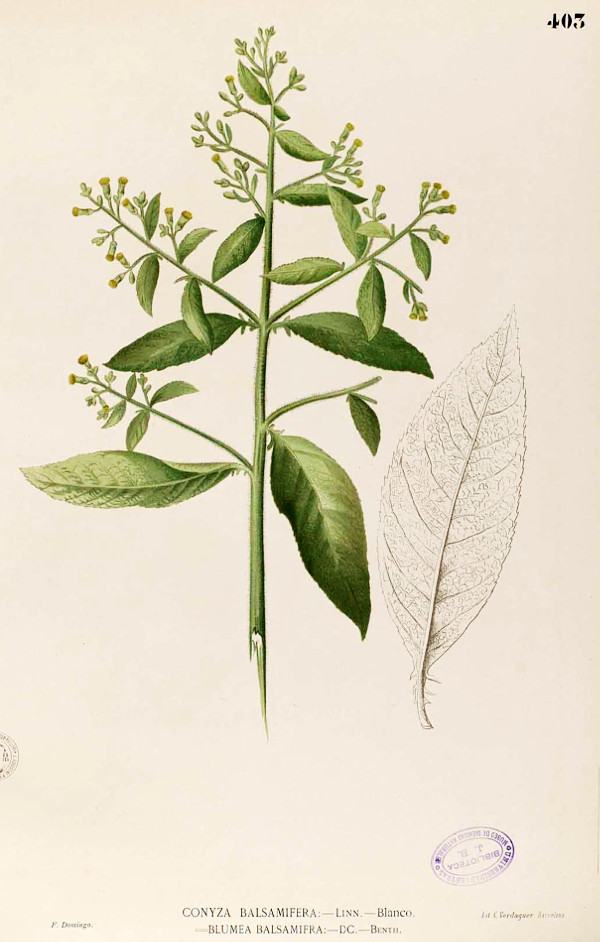Blumea balsamifera (L.) DC. - syn.Conyza balsamifera L. (basionym); Placus balsamifer (L.) Baill. - Asteraceae
sambong, buffalo-ear, ngai camphor, Büffelohr
Perennial, erect, aromatic (sub-)shrub up to 3m tall, native to Southeast Asia; stem corymbosely branched, woody at base; leaves oblong, abaxially densely silky-lanate, adaxially rugose and pilose; flowers yellow.
http://www.efloras.org/florataxon.aspx?flora_id=2&taxon_id=200023545
„Blumea balsamifera is used as an herbal treatment for the common cold and as a diuretic in Philippine medicine, where it is most commonly known as sambong. It is used to treat infected wounds, respiratory infections, and stomach pains in Thai and Chinese folk medicine.“
http://en.wikipedia.org/wiki/Blumea_balsamifera
„GC-MS analysis of essential oil of Blumea balsamifera (L.) DC. leaf revealed the presence of 50 components, contributing to 99.07% of the oil. The dominant components in the oil from leaves were borneol (33.22%), caryophyllene (8.24%), ledol (7.12%), tetracyclo[6,3,2,0,(2.5).0(1,8) tridecan-9-ol, 4,4-dimethyl (5.18%), phytol (4.63%), caryophyllene oxide(4.07%), guaiol (3.44%), thujopsene-13 (4.42%), dimethoxydurene (3.59%) and γ-eudesmol (3.18%).“
[Chemical components in volatile oil from Blumea balsamifera (L.) DC., Bhuiyan, M.N.I., Chowdhury, J.U., Begum, J., Bangladesh Journal of Botany, Vol.38(1), 2009, 107-109]
„The main components of the essential oil of B. balsamifera were 1,8-cineole (20.98%), borneol (11.99%), β-caryophyllene (10.38%), camphor (8.06%), 4-terpineol (6.49%), α-terpineol (5.91%), and caryophyllene oxide (5.35%).“
[Fumigant compounds from the essential oil of Chinese Blumea balsamifera leaves against the maize weevil (Sitophilus zeamais)., Chu, S.S., Du, S.S., Liu, Z.L., Journal of Chemistry, 2012, 2013]
http://downloads.hindawi.com/journals/chem/2013/289874.pdf
„Leaves of Blumea balsamifera (Lin.) DC. are used in traditional Thai and Chinese medicine for the treatment of septic wounds and other infections… the essential oil, hexane, dichloromethane and methanol extracts of these leaves were evaluated for antibacterial and antifungal activities using the disc diffusion assay and agar microdilution method. The essential oil was the most potent, with a minimum inhibitory concentration (MIC) of 150 µg mL−1 against Bacillus cereus and an MIC of 1.2 mg mL−1 against Staphylococcus aureus and Candida albicans. Activity was also detected from the hexane extract against Enterobacter cloacae and S. aureus. Minimum bactericidal and fungicidal concentrations were typically equal to or two-fold higher than the MICs for both extracts, indicating microbicidal activity.“
[Antimicrobial activity of Blumea balsamifera (Lin.) DC. extracts and essential oil., Sakee, U., Maneerat, S., Cushnie, T.T., De-Eknamkul, W., Natural product research, Vol.25(19), 2011, 1849-1856]

Blanco, M., Flora de Filipinas, t. 403 (1875)
http://plantgenera.org/species.php?id_species=147409
